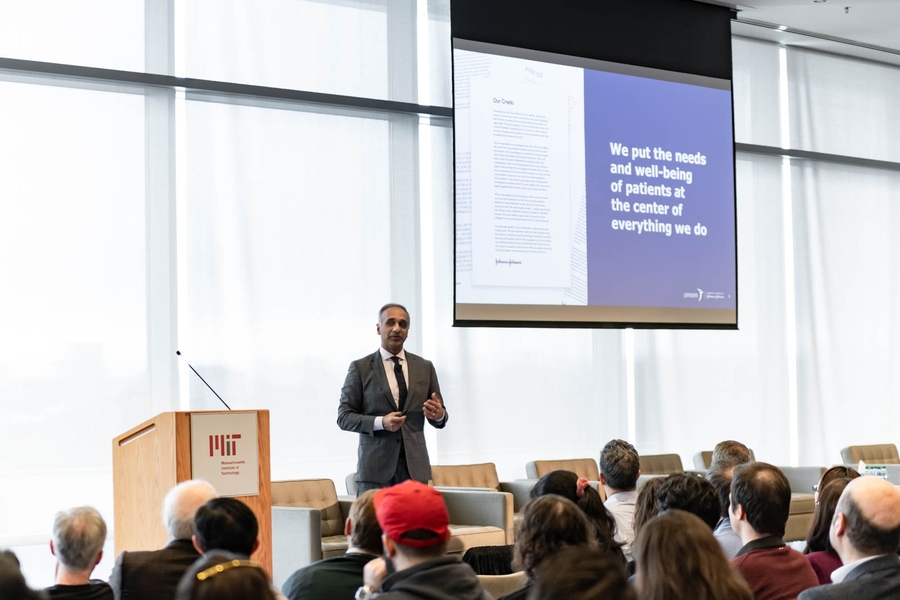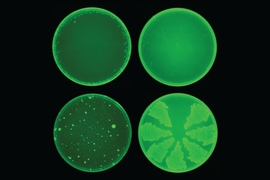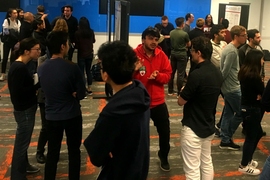Developing drugs to combat Covid-19 is a global priority, requiring communities to come together to fight the spread of infection. At MIT, researchers with backgrounds in machine learning and life sciences are collaborating, sharing datasets and tools to develop machine learning methods that can identify novel cures for Covid-19.
This research is an extension of a community effort launched earlier this year. In February, before the Institute de-densified as a result of the pandemic, the first-ever AI Powered Drug Discovery and Manufacturing Conference, conceived and hosted by the Abdul Latif Jameel Clinic for Machine Learning in Health, drew attendees including pharmaceutical industry researchers, government regulators, venture capitalists, and pioneering drug researchers. More than 180 health care companies and 29 universities developing new artificial intelligence methods used in pharmaceuticals got involved, making the conference a singular event designed to lift the mask and reveal what goes on in the process of drug discovery.
As secretive as Silicon Valley seems, computer science and engineering students typically know what a job looks like when aspiring to join companies like Facebook or Tesla. But the global head of research and development for Janssen — the innovative pharmaceutical company owned by Johnson & Johnson — said it’s often much harder for students to grasp how their work fits into drug discovery.
“That’s a problem at the moment,” Mathai Mammen says, after addressing attendees, including MIT graduate students and postdocs, who gathered in the Samberg Conference Center in part to get a glimpse behind the scenes of companies currently working on bold ideas blending artificial intelligence with health care. Mathai, who is a graduate of the Harvard-MIT Program in Health Sciences and Technology and whose work at Theravance has brought to market five new medicines and many more on their way, is here to be part of the answer to that problem. “What the industry needs to do, is talk to students and postdocs about the sorts of interesting scientific and medical problems whose solutions can directly and profoundly benefit the health of people everywhere” he says.
“The conference brought together research communities that rarely overlap at technical conferences,” says Regina Barzilay, the Delta Electronics Professor of Electrical Engineering and Computer Science, Jameel Clinic faculty co-lead, and one of the conference organizers. “This blend enables us to better understand open problems and opportunities in the intersection. The exciting piece for MIT students, especially for computer science and engineering students, is to see where the industry is moving and to understand how they can contribute to this changing industry, which will happen when they graduate.”
Over two days, conference attendees snapped photographs through a packed schedule of research presentations, technical sessions, and expert panels, covering everything from discovering new therapeutic molecules with machine learning to funding AI research. Carefully curated, the conference provided a roadmap of bold tech ideas at work in health care now and traced the path to show how those tech solutions get implemented.
At the conference, Barzilay and Jim Collins, the Termeer Professor of Medical Engineering and Science in MIT’s Institute for Medical Engineering and Science (IMES) and Department of Biological Engineering, and Jameel Clinic faculty co-lead, presented research from a study published in Cell where they used machine learning to help identify a new drug that can target antibiotic-resistant bacteria. Together with MIT researchers Tommi Jaakkola, Kevin Yang, Kyle Swanson, and the first author Jonathan Stokes, they demonstrated how blending their backgrounds can yield potential answers to combat the growing antibiotic resistance crisis.
Collins saw the conference as an opportunity to inspire interest in antibiotic research, hoping to get the top young minds involved in battling resistance to antibiotics built up over decades of overuse and misuse, an urgent predicament in medicine that computer science students might not understand their role in solving. “I think we should take advantage of the innovation ecosystem at MIT and the fact that there are many experts here at MIT who are willing to step outside their comfort zone and get engaged in a new problem,” Collins says. “Certainly in this case, the development and discovery of novel antibiotics, is critically needed around the globe.”
AIDM showed the power of collaboration, inviting experts from major health-care companies and relevant organizations like Merck, Bayer, Darpa, Google, Pfizer, Novartis, Amgen, the U.S. Food and Drug Administration, and Janssen. Reaching capacity for conference attendees, it also showed people are ready to pull together to get on the same page. “I think the time is right and I think the place is right,” Collins says. “I think MIT is well-positioned to be a national, if not an international leader in this space, given the excitement and engagement of our students and our position in Kendall Square.”
A biotech hub for decades, Kendall Square has come a long way since big data came to Cambridge, Massachusetts, forever changing life science companies based here. AIDM kicked off with Institute Professor and Professor of Biology Phillip Sharp walking attendees through a brief history of AI in health care in the area. He was perhaps the person at the conference most excited for others to see the potential, as through his long career, he’s watched firsthand the history of innovation that led to this conference.
“The bigger picture, which this conference is a major part of, is this bringing together of the life science — biologists and chemists with machine learning and artificial intelligence — it’s the future of life science,” Sharp says. “It’s clear. It will reshape how we talk about our science, how we think about solving problems, how we deal with the other parts of the process of taking insights to benefit society.”









